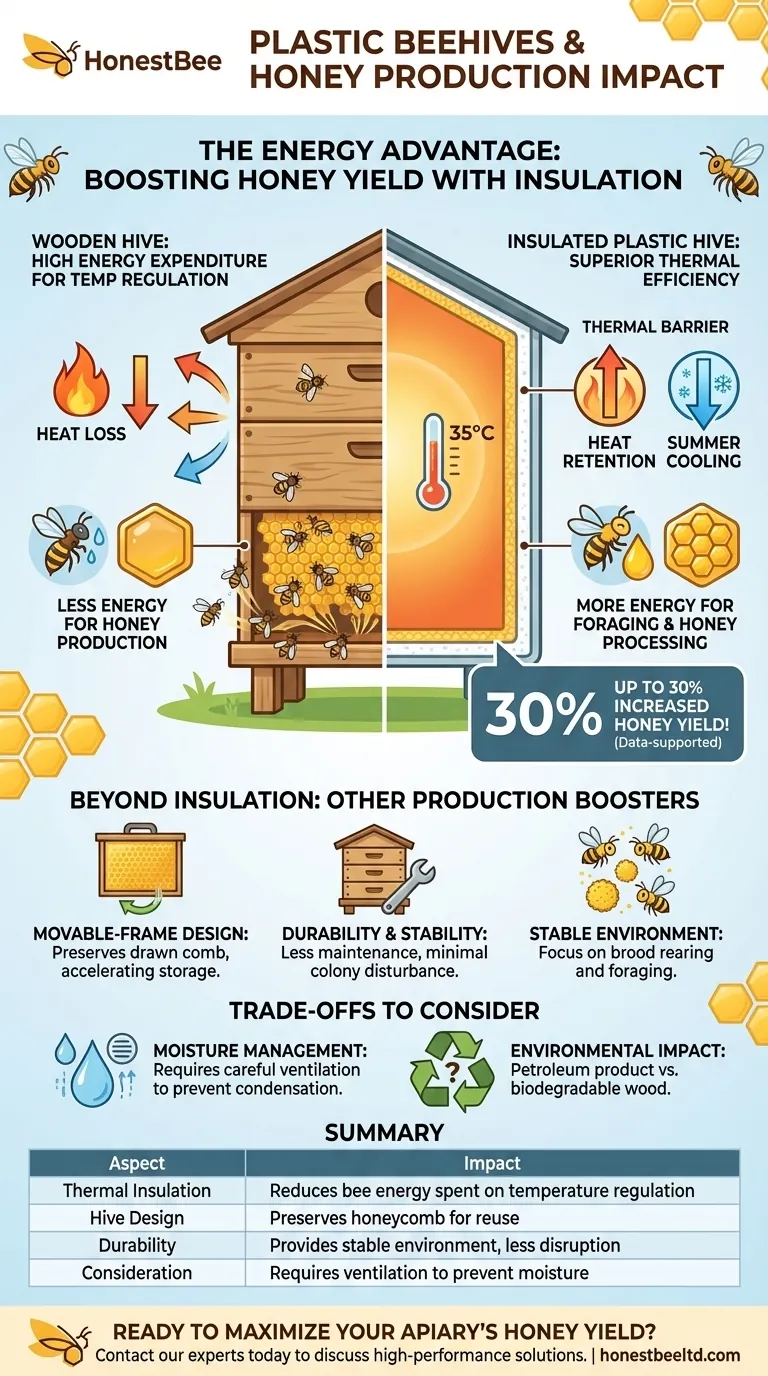In short, plastic beehives, particularly those made from high-density polystyrene, often lead to increased honey production. This is primarily because their superior insulation properties reduce the energy bees must expend to regulate the internal temperature of the hive, freeing them up for foraging and honey processing.
The central principle is energy conservation. By providing a thermally stable environment, insulated plastic hives allow a honeybee colony to allocate more of its collective energy toward gathering nectar and producing honey, rather than simply surviving the elements.

The Core Mechanism: Thermal Efficiency
A honeybee colony functions like a single organism, constantly working to maintain a stable internal environment. The brood nest, where young bees are raised, must be kept at a consistent 35°C (95°F), regardless of the outside weather.
Reducing Energy Expenditure
In traditional wooden hives, bees must consume significant amounts of their own honey stores to generate heat in the winter. In the summer, they expend energy fanning their wings and collecting water to evaporatively cool the hive.
This constant effort to regulate temperature comes at a direct cost to productivity.
The Advantage of Insulation
High-density Expanded Polystyrene (EPS) hives function like a thermos. Their material has much lower thermal conductivity than wood, meaning heat transfers through it much more slowly.
This keeps the hive warmer in the winter and cooler in the summer with far less effort from the bees. One major commercial beekeeper even reported a honey yield increase of up to 30% after switching to EPS hives.
Translating Energy into Honey
When bees are not burning through their food reserves for climate control, that energy is redirected. The colony can support a larger population, and more forager bees can dedicate their time to collecting nectar, resulting in a larger honey surplus for the beekeeper.
Beyond Insulation: Other Factors Aiding Production
While thermal efficiency is the primary driver, other aspects of modern plastic hives also contribute to a healthier, more productive colony.
Hive Design and Comb Preservation
Most plastic hives are of the movable-frame Langstroth design. This system is crucial for high honey yields because it allows the beekeeper to extract honey without destroying the beeswax comb.
Rebuilding comb is an incredibly energy-intensive task for bees. By preserving the drawn-out comb, the colony can immediately reuse it for honey storage, dramatically accelerating production.
Durability and a Stable Environment
Plastic hives are non-porous and do not rot, warp, or require painting. This durability means fewer hive repairs and less disturbance to the colony over its lifespan.
A stable, predictable home with minimal disruption allows the bees to focus their efforts on brood rearing and foraging, which are the engines of honey production.
Understanding the Trade-offs
While effective, plastic hives are not without their considerations. Objectivity requires acknowledging their potential downsides compared to traditional wood.
Moisture and Ventilation
Wood is naturally breathable, allowing some moisture to escape. Plastic is not. Improperly ventilated plastic hives can lead to condensation buildup, especially in cold, damp climates.
This moisture can stress the colony and promote mold. Beekeepers using plastic hives must be more deliberate about providing adequate top and bottom ventilation.
Environmental Impact
Wood is a natural, biodegradable material. Plastic hives, while durable, are a petroleum product.
For beekeepers committed to a "natural" or sustainable approach, the long-term environmental footprint of plastic is a significant factor to weigh.
Making the Right Choice for Your Goal
The best hive material is not a universal answer; it depends entirely on your climate, management style, and beekeeping philosophy.
- If your primary focus is maximizing honey yield: An insulated polystyrene hive offers a clear, data-supported advantage in most climates.
- If your primary focus is a traditional or "natural" methodology: A wooden hive remains the classic and sustainable choice, though it may require more maintenance.
- If you are in a region with extreme hot or cold temperatures: The thermal stability of an insulated plastic hive is a powerful tool for ensuring colony survival and productivity.
Ultimately, choosing the right equipment is about understanding how it helps or hinders the natural work of your bees.
Summary Table:
| Aspect | Impact on Honey Production |
|---|---|
| Thermal Insulation | Reduces bee energy spent on temperature regulation, freeing them for foraging. |
| Hive Design | Preserves honeycomb, allowing immediate reuse and faster honey storage. |
| Durability | Provides a stable environment with less disruption, promoting colony focus. |
| Potential Consideration | Requires careful ventilation management to prevent moisture buildup. |
Ready to maximize your apiary's honey yield?
At HONESTBEE, we specialize in supplying high-performance beekeeping supplies and equipment, including advanced insulated hives, to commercial apiaries and distributors. Our wholesale-focused operations are designed to help you achieve greater efficiency and profitability.
Contact our experts today to discuss how our solutions can conserve your bees' energy and significantly boost your honey production.
Visual Guide

Related Products
- Beehive Entrance Discs Plastic Bee Entrance Disc for Bee Hives
- Food Grade Plastic bee Foundation for Bee Frames
- Professional Galvanized Hive Strap with Secure Locking Buckle for Beekeeping
- Professional Drop-Style Hive Handles for Beekeeping
- Professional Hive Top Bee Feeder for Beekeeping
People Also Ask
- What is the importance of understanding the function of each part of the beehive? Master Your Hive for a Thriving Colony
- Why is proper beekeeping equipment important? Essential for Safety and Hive Health
- What type of bees are better adapted to certain climatic conditions? Match Bee Strategy to Your Climate for Success
- Where is the hive entrance typically located? Optimize Your Hive's Health and Honey Production
- How is the circular metal beehive entrance disc mounted? Simple Pivot Installation for Smart Hive Management



















